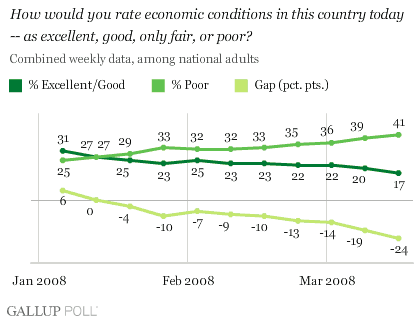PRINCETON, NJ -- More Americans are rating the economy "poor" and fewer are rating it "excellent" or "good" as every week passes in 2008.

Consumer Ratings Declining Weekly
Over the weekend, the Federal Reserve bailed out Bear Stearns as the latter experienced what might be called an old-fashioned "run on the bank." The Fed also lowered the discount rate and, more importantly, allowed most securities firms access to the discount window to provide them with ready availability to emergency liquidity. The Fed is acting to stabilize the financial sector during a chaotic situation in the global financial markets.
When the Federal Open Market Committee (FOMC) meets on Tuesday, it will focus on its responsibility to maintain financial stability. However, Gallup's daily tracking of Americans' economic perceptions suggests it should also keep consumer confidence in mind. The Fed needs to act to bolster consumer perceptions, not just confidence in the financial markets.
During the first week of January, more consumers rated current economic conditions "excellent" or "good" (31%) than rated them "poor" (25%), for a difference of +6 percentage points. By the fourth week of the month (Jan. 21-27), these percentages had reversed, with about one in four consumers rating the economy as excellent or good (23%) while one in three rated it as poor (33%), for a difference of -10 points. After improving slightly in early February, consumer ratings continued deteriorating, so that by the last week of February, the difference was -14 points -- a difference that increased to -24 points for the most recent week of data (March 10-16).
Ratings Gap Is Climbing the Income Distribution Scale
During the first week of January, 22% of those making less than $24,000 a year rated current economic conditions as excellent or good while 36% rated them as poor, for a difference of -14 points. At that time, the comparable gap among those making $24,000 to less than $60,000 a year was 0. In sharp contrast, the gap among those making $60,000 to less than $90,000 was +24 and among those making at least $90,000, it was +23.
Over the past 11 weeks, economic ratings have deteriorated across all income groups. During the week of March 10-16, the gap among those making less than $24,000 a year has increased to -36 points, while the gap among those making $24,000 to less than $60,000 is -26. Among those making $60,000 to less than $90,000, January's +24 gap has become -13. The January gap of +23 among those making $90,000 or more a year is now -10.

Will Consumer Confidence Get Worse Before It Gets Better?
The FOMC is expected to lower interest rates significantly at its Tuesday meeting -- anywhere from ½ point to 1 full percentage point. While such a drop may have only a limited benefit in terms of consumer and investor confidence, it will lower the cost of money to the nation's financial institutions and, thus, help them to weather the financial storm.
The problem is that the average American consumer is not really suffering from the current level of interest he or she is paying to borrow money. Instead, consumers are being buffeted by surging energy and food prices, declining housing prices, job cuts, and worries about the safety of their financial investments, not to mention the lower interest rates available to them on federally insured deposits.
At this point, it is not clear that the Fed can do what is necessary to stabilize the financial markets and build consumer/investor confidence. In fact, to the degree that these actions are seen as signs that the current financial situation is worse than previously anticipated, the Fed's actions may actually have the opposite effect -- and reduce consumer confidence.
The reality is that it may take direct and dramatic action by the president and the U.S. Treasury to significantly and positively affect consumer confidence. In this regard, the statements by Treasury Secretary Paulson over the weekend concerning the Bear Stearns bailout and the U.S. dollar, as well as those of the president Monday reassuring Americans that the U.S. economy is sound, might be seen as something of a disappointment by the markets. Of course, the situation may change in the days and weeks ahead -- particularly if Gallup's daily polling shows consumer confidence continuing to deteriorate.
Survey Methods
Gallup is interviewing no fewer than 1,000 U.S. adults nationwide each day during 2008. The economic questions analyzed in this report are asked of a random half-sample of respondents. The results reported here are based on combined data of approximately 3,500 interviews conducted per week. For results based on this sample, the maximum margin of sampling error is ±2 percentage points. In addition to sampling error, question wording and practical difficulties in conducting surveys can introduce error or bias into the findings of public opinion polls.
